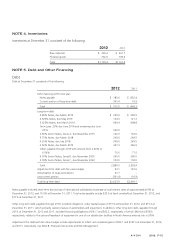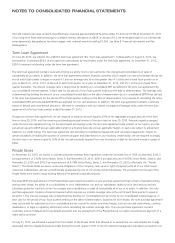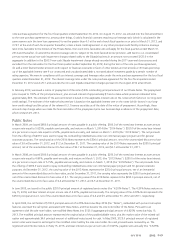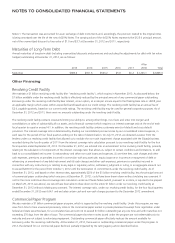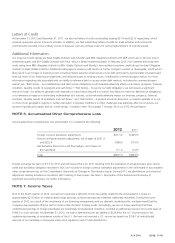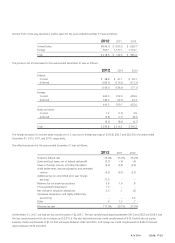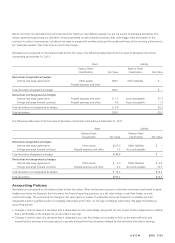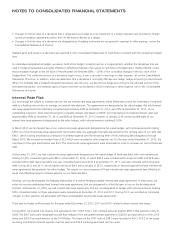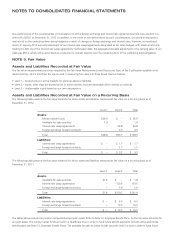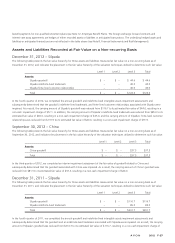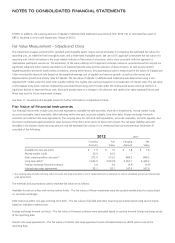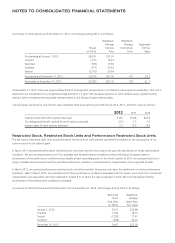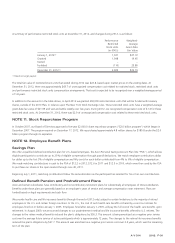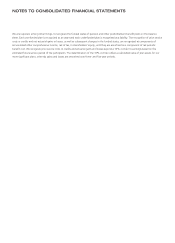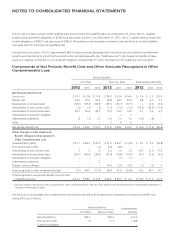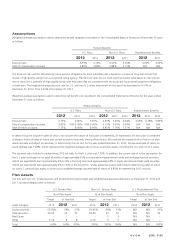Avon 2012 Annual Report Download - page 90
Download and view the complete annual report
Please find page 90 of the 2012 Avon annual report below. You can navigate through the pages in the report by either clicking on the pages listed below, or by using the keyword search tool below to find specific information within the annual report.
During 2005, we entered into treasury lock agreements (the “2005 locks”) that we designated as cash flow hedges and used to hedge
exposure to a possible rise in interest rates prior to the anticipated issuance of ten- and 30-year bonds. In December 2005, we decided that a
more appropriate strategy was to issue five-year bonds given our strong cash flow and high level of cash and cash equivalents. As a result of
the change in strategy, in December 2005, we de-designated the 2005 locks as hedges and reclassified the gain of $2.5 on the 2005 locks
from AOCI to other expense, net. Upon the change in strategy in December 2005, we entered into a treasury lock agreement (the
“additional 2005 locks”) with a notional amount of $250.0 designated as a cash flow hedge of the $500.0 principal amount of five-year
notes payable issued in January 2006. The loss on the additional 2005 locks of $1.9 was recorded in AOCI and has been amortized to
interest expense over five years.
During 2003, we entered into treasury lock agreements (the “2003 locks”) that we designated as cash flow hedges and used to hedge the
exposure to the possible rise in interest rates prior to the issuance of the 4.625% Notes. The loss on the 2003 locks of $2.6 was recorded in
AOCI and is being amortized to interest expense over ten years.
As of December 31, 2012, we expect to reclassify $1.7, net of taxes, of net losses on derivative instruments designated as cash flow hedges
from AOCI to earnings during the next 12 months.
For the years ended December 31, 2012 and 2011, treasury lock agreements impacted AOCI as follows:
2012 2011
Net unamortized losses at beginning of year, net of taxes of $5.8 and $7.9 $(10.7) $(14.6)
Reclassification of net losses to earnings, net of taxes of $2.1 and $2.1 3.9 3.9
Net unamortized losses at end of year, net of taxes of $3.7 and $5.8 $ (6.8) $(10.7)
Foreign Currency Risk
At December 31, 2012, the primary currencies for which we had net underlying foreign currency exchange rate exposures were the
Argentine peso, Australian dollar, Brazilian real, British pound, Canadian dollar, Chinese renminbi, Colombian peso, the Czech Republic
koruna, the euro, Mexican peso, New Zealand dollar, Peruvian new sol, Philippine peso, Polish zloty, Russian ruble, South Africa rand,
Turkish lira, Ukrainian hryvnia, and Venezuelan bolívar. We use foreign exchange forward contracts to manage a portion of our foreign
currency exchange rate exposures. At December 31, 2012, we had outstanding foreign exchange forward contracts with notional amounts
totaling approximately $315.3 for the euro, British pound, Mexican peso, Peruvian new sol, the Czech Republic koruna, Polish zloty,
Romanian leu, and New Zealand dollar.
We use foreign exchange forward contracts to manage foreign currency exposure of intercompany loans. These contracts are not
designated as hedges. The change in fair value of these contracts is immediately recognized in earnings and substantially offsets the foreign
currency impact recognized in earnings relating to the intercompany loans. During 2012 and 2011, we recorded gains of $7.6 and $8.7,
respectively, in other expense, net related to these undesignated foreign exchange forward contracts. Also during 2012 and 2011, we
recorded losses of $4.6 and $3.2, respectively, related to the intercompany loans, caused by changes in foreign currency exchange rates.
We also have used foreign exchange forward contracts and foreign currency-denominated debt to hedge the foreign currency exposure
related to the net assets of foreign subsidiaries, which were effective as hedges. Gains of $4.3 for 2012 and $2.8 for 2011, and a loss of
$3.7 for 2010, related to the effective portions of these hedges were included in foreign currency translation adjustments within AOCI on
the Consolidated Balance Sheets. During 2010 a loss of $20.1 was reclassified from AOCI to discontinued operations due to the sale of
Avon Japan. During 2011, we identified an out-of-period adjustment relating to balances included in AOCI relating to Avon Japan. See Note
1, Description of the Business and Summary of Significant Accounting Policies, for further information.
Credit Risk of Financial Instruments
We attempt to minimize our credit exposure to counterparties by entering into derivative transactions and similar agreements with major
international financial institutions with “A” or higher credit ratings as issued by Standard & Poor’s Corporation. Our foreign currency and
interest rate derivatives are comprised of over-the-counter forward contracts, swaps or options with major international financial institutions.
Although our theoretical credit risk is the replacement cost at the then estimated fair value of these instruments, we believe that the risk of
incurring credit risk losses is remote and that such losses, if any, would not be material.
A V O N 2012 F-25


